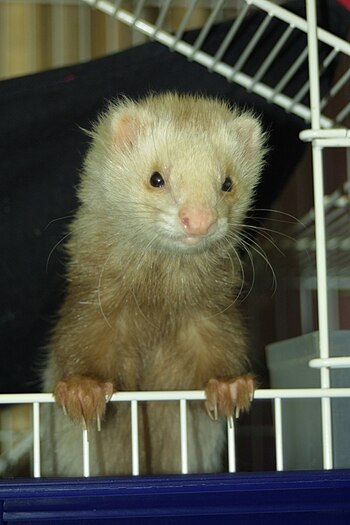There are different kinds of domesticated ferrets. If you want something exotic, why not try the Angora ferret?
The angora ferret began in Sweden when a breeder noticed a mutation among his ferrets as they produced longer hair on the hind legs and rear part of their bodies. The offspring were then sold to another breeder until they found their way into the US.
 |
| An Angora Ferret “Ranko” (Photo credit: Wikipedia) |
It is very challenging to breed an angora ferret because it requires 10 short hair ferrets that each carries the desired gene. This means that along the way, several variations are created.
Marc Morrone is the only breeder in the US that sells angora ferrets coming from Europe. If you are interested in getting one, you should get in touch with him. Be prepared though to spend a few more dollars given that they are imported.
If this is way beyond your budget, try your luck in an animal shelter. Who knows? Perhaps someone who owned one in the past decided to give it up.
When you are looking at the angora ferrets on hand, pay attention to their eyes and their behavior. If they are bright and they are very friendly, then this is probably the one you should bring home with you. Make sure that you already have a cage to house them so they have their own space when it is time for them to go to bed.
This should be big enough for them to move and play around in especially when you also have to buy a few toys for them to play with.
Aside from a cage, you should ask Marc Morrone tips on taking care of this mammal. Just like other pets that you have had in the past, there are some do’s and don’ts that you have to follow so that there won’t be any problems between you and your new friend.
You will probably be told to follow a strict diet consisting of meat and poultry products since ferrets prefer a meal that is high in protein and low in fat. You must never feed them anything that is rich in carbs or sugar and those that are intended for other animals.
As the angora ferret grows older, you can substitute its diet with bones and other items as their need for protein decreases.
It will also be advisable to ferret proof your home so they do not cause any damage or hurt themselves. Since they are quite small and they might take a nap just about anywhere in the room, check under the cushion of the couch before you sit down.
Don’t forget to bring the angora ferret to the vet for its annual vaccinations to prevent the spread of rabies or having it succumb to illness.
The angora ferret can also be toilet trained so they won’t dump their waste on your carpet. It is also possible to teach them to do a few tricks which will surely amaze those who get to see your new pet.
Everyone deserves to have a pet. Sure, you can settle for a dog, cat or a goldfish but it is nothing compared to the love and playfulness of a friendly and sociable exotic little creature like the long haired Angora ferret. If it is legal to own one where you live, by all means go ahead and get one.
